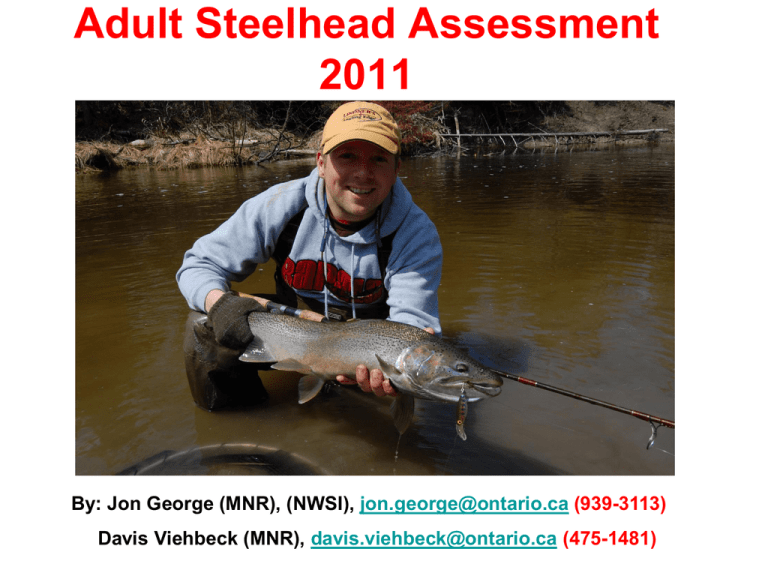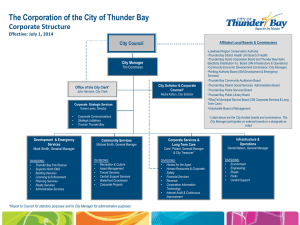
Adult Steelhead Assessment
2011
By: Jon George (MNR), (NWSI), jon.george@ontario.ca (939-3113)
Davis Viehbeck (MNR), davis.viehbeck@ontario.ca (475-1481)
Co-op Angler 2011
(A partnership in science between the Ministry of Natural Resources and the
North Shore Steelhead Association)
•
•
•
•
Introduction
Three steelhead assessment projects were conducted
during the spring of 2011
They are as follows:
A) McIntyre River Steelhead Population Assessment
B) Portage Creek Steelhead Population Assessment
C) Co-op Angler Study
All studies were conducted in partnership with the North
Shore Steelhead Association and the Ministry of Natural
Resources
This report summarizes the three studies and discusses
the overall health of steelhead stocks from Thunder Bay
to Marathon (Lake Superior).
Steelhead Assessment 2011 (A partnership between
MNR and the NSSA)
Steelhead anglers from the North Shore Steelhead Association (NSSA), in conjunction with the
Ontario Ministry of Natural Resources (MNR), collected 1255 adult steelhead data samples (fork
length, sex and scales) from twenty-two Lake Superior tributary streams from Thunder Bay to
Marathon (April and May 2011). Two tributaries, McIntyre River (Thunder Bay) and Portage Creek
(Black Bay), were used as “Index Streams” to estimate the steelhead population size in each
basin.
Methods
Sampling kits (knife, measuring tape, gloves, scale envelopes, pencil and instructions) were
supplied to interested anglers. A workshop was held April 15, 2011 where participants received an
overview of the program and sampling instructions were distributed. Anglers were to sample adult
steelhead during their angling endeavours between April and June. Names and email addresses
were recorded from anglers receiving kits. Samples were to be returned to MNR by mid-June.
Follow-up emails and phone calls were made in June.
Life history data (Appendix 1), extracted from the scale samples (Figure 1) and the data entry in
an Excel data base were conducted by (North Shore Environmental Services) NSES. On the
McIntyre River and Portage Creek, we also estimated population size using an annular fin clip
series shown in appendices 2 and 3.
The population estimates were based on a ‘Petersen Population Estimate’ shown in Appendix 4.
Adult steelhead are fin clipped in year one and recaptured in year two. The repeat spawners with
fin clips in year two complete the formula.
2011 Projects
A)
McIntyre River Steelhead Population Assessment
Four members of the North Shore Steelhead Association (with extensive
experience at handling, biologically sampling and tagging steelhead) were
required to angle, fin clip (tag a subset) and collect length, sex and scale samples
from the adult steelhead population from April until June Appendix 2.
B) Portage Creek Steelhead Population Assessment
Members of the North Shore Steelhead Association conducted the steelhead
capture (angling) and the Ministry of Natural Resources conducted the biological
sampling and tagging from April to June Appendix 3.
C) Co-op Angler Study
Steelhead anglers attended a workshop held during early April. They were given
an overview of the program. Sampling kits were distributed to anglers so they
could sample the steelhead they caught during normal angling trips during the
spring of 2011.
Collecting the data
Sample Kit
Gender (male or female ?)
Measuring length
Scale Sample
Steelhead Scale:
Age 5 years
(2 stream, 3 lake,
3rd spawn)
Life History Extrapolation
Third Lake Year,
Third Spawn
Second Lake
Year, Second
Spawn
First Lake
Year, First
Spawn
Second
Stream
Year
First Stream
Year
Figure 1.
Table 1.
Co-op Angler 2011
Steelhead Samples by Tributary
A) Thunder Bay
Whitefish River
Neebing River
McIntyre River
McVicar Creek
Wild Goose Creek
Current River
McKenzie River
78
52
410
27
11
3
8
B) Black Bay
Portage Creek
Coldwater / Spring Creek
Wolf River
Black Sturgeon River
210
22
36
4
C) Terrace Bay
Jackpine River
Cypress River
Gravel River
Little Gravel River
Dublin River
McInnis River
Hewittson River
Mcleans River
Steel River
Prairie River
Deadhorse River
78
185
8
22
5
3
2
5
17
78
2
McIntyre, Portage Creek Population Trends
•
2600
McInty re
Population Size
•
These two graphs indicate the trends in
adult steelhead population size up to the
present time. Figure A is the McIntyre River,
Thunder Bay, Figure B is Portage Creek,
Black Bay.
In Figure A, the McIntyre River maintained a
population size of approximately 400 adults
increasing to 900 in 2004, 1500 in 2008 and
to 2400 in 2010. Catch limits were reduced
from five per day to two per day (one over
50cm, one under 50 cm) in 1996, and to one
per day (maximum size of 69 cm) in the
spring of 1999.
In Figure B, Portage Creek was closed to
fishing in the spring of 2004 (previously had
a five-fish daily limit). The adult population
size increased from 600 fish in 1992 to over
1000 in 1999. By 2004, the population size
exceeded 2000, remained above 1600 until
2008, then declined to 600 adults in 2010.
2100
1600
1100
600
100
99
0
1
3
4
Fig. A
5
6
7
8
9
10
Year
Note: 1999 to 2004 (Counting Fence), 2008 to 2010 (Petersen est. )
Adult Population Size 1991 to 2010
2200
2000
Portage
1800
Number of Adults
•
Adult Population Estimates
1600
1400
1200
1000
800
600
400
Fig. B
200
91 92 93 94 95 96 97 98 99
0
1
Year
2
3
4
5
6
7
8
9
10
Thunder Bay
Age Structure 2011
A)
50
Percent of Total
40
Whitefish
Neebing
McIntyre
McVicar
30
20
10
Fig. A
0
2(09)
3(08)
4(07)
5(06)
6(05)
7(04)
8(03)
Age (year of birth)
Number of Stream Years 2011
100
Whitefish
Neebing
McIntyre
McVicar
80
Percent of Total
A)
In the Thunder Bay basin, the following
tributaries were sampled: Whitefish,
Neebing, McIntyre Rivers and McVicar
Creek.
The 2004 year class, now aged seven
years, remains prominent in all rivers with
the exception being McVicar Creek. Age
three-and four-year old fish from 2007 and
2008 were dominant in McVicar Creek,
the Neebing River (2008) and the
McIntyre River (2007)
Wild Goose Creek had age two to four
year old adults with no fish older than age
4 years (small sample size).
Most Thunder Bay stream steelhead have
two stream years prior to migrating to
Lake Superior (smolting). The Neebing
River fish favoured one year of stream
life.
Wild Goose Creek had only one stream
year adults present.
60
40
20
0
Fig. B
1
2
Number of Stream Years
3
9(02)
Black Bay
Age Structure 2011
B)
50
Portage
Coldwater
Wolf
Percent of Total
40
30
20
10
0
Fig. A
2(09)
3(08)
4(07)
5(06)
6(05)
7(04)
8(03)
9(02)
10(01) 11(00)
Age (year of birth)
Number of Stream Years 2011
100
80
Percent of Total
A)
The Black Bay Basin includes three
tributaries: Portage Creek, Coldwater and
Wolf Rivers.
Age seven steelhead from the 2004 year
class remain strong in all three rivers. The
Coldwater River had a high percentage of
age three and age four year steelhead
from the 2007 and 2008 year classes.
Portage Creek and the Wolf River were
the only tributaries sampled with adult
steelhead older than age seven. Age ten
and eleven year steelhead were present
in the Wolf River and Portage Creek
watersheds.
Stream life was divided between one and
two years in both the Coldwater and Wolf
Rivers. Portage Creek was dominated by
age one smolts.
Portage
Coldwater
Wolf
60
40
20
0
Fig. B
1
2
Number of Stream Years
3
Nipigon to Marathon
B)
Age Structure 2011
50
Jackpine
Cypress
Prairie
Percent of Total
40
30
20
10
0
Fig. A
2(09)
3(08)
4(07)
5(06)
6(05)
7(04)
8(03)
9(02)
10(01)
Age (year of birth)
Number of Stream Years 2011
100
80
Percent of Total
A)
The Nipigon to Marathon shoreline of
Lake Superior is represented by three
larger tributaries: Jackpine, Cypress and
Prairie Rivers. Smaller tributaries (e.g.
Dublin, McInnis, Little Gravel and
Hewittson Creeks) had small sample
sizes so were grouped together for
analyses.
As with Thunder Bay and Black Bay, the
2004 year class (age seven years) still
remains prominent in the spawning
population. Early recruitment of age two
males (2009 year class) was a bit of a
surprise in the Jackpine and Cypress
Rivers. The Prairie River was dominated
by ages four to seven, with no younger
spawning fish sampled in this year’s adult
population. The 2006 year class was the
strongest in all three tributaries.
In the smaller tributaries, age four year
steelhead (2007) were strongest at 24%.
The 2004 year class, age seven were at
20%. A total of 4% of the sample were
age eight to ten years old.
The Jackpine and Cypress River
steelhead have mostly one year of stream
life before migrating to Lake Superior. The
Prairie River had a dominance of two year
smolts. Age three year smolts were rare
(Fig. B).
Small tributaries had 56% one stream
year and 44 % two years.
Jackpine
Cypress
Prairie
60
40
20
0
1
Fig. B
2
Number of Stream Years
3
Thunder Bay Steelhead
Age at First Spawning
B)
In Thunder Bay tributaries, at least
fifty percent of the spawning
populations were repeat spawners.
McVicar Creek was the exception
with 41% spawning more than
once. All tributaries had adults
spawning for the fifth consecutive
year. The McIntyre River had a
small percentage of adults
spawning for the sixth and seventh
years.
Wild Goose Creek had a 40%
repeat spawning rate.
70
Whitefish
Neebing
McIntyre
McVicar
60
Percent of Total
In the Thunder Bay tributaries that
were sampled, steelhead spawn for
the first time at ages three, four and
five years. Females generally
require two lake years prior to
spawning for the first time. Males
are often only one lake year at
maturity. Females are mostly age
three and older at first spawn, with
males often reaching maturity at
two and three years of age. The
Neebing River and McVicar Creek
had a high percentage of age five
first-time spawners (mostly
females) with three lake years prior
to spawning for the initial time.
50
40
30
20
10
0
2
3
Fig. A
4
5
6
Age at First Spawning
Number of Spawning Events 2011
70
60
Percent of Total
A)
Whitefish R=65%
Neebing R=50%
McIntyre R=54%
McVicar R=41%
50
40
30
20
10
0
M
2
Fig. B
3
4
Age
R= repeat spawning percentages
5
6
7
Black Bay Steelhead
Age at first spawning 2011
Portage
Coldwater
Wolf/Black Sturgeon
70
60
Percent of Total
B)
In the Black Bay tributaries, steelhead
matured mostly at three and four
years of age. Age two fish were
mostly males and steelhead aged five
at maturity were predominantly
females.
Portage Creek and the Wolf River
have high repeat spawning rates and
multiple spawning, from six to nine
times. The Coldwater River had a
lower repeat spawning rate than the
other two tributaries that were
sampled.
50
40
30
20
10
Fig. A
0
2
3
4
5
Age at First Spawning
Number of Spawning Events 2011
70
60
Percent of Total
A)
Portage R=69%
Coldwater R=41%
Wolf R=62.5%
50
40
30
20
10
0
M
Fig. B
2
3
4
5
6
7
Number of Spawning Events
R= repeat spawning percentages
8
9
Nipigon to Marathon
Age at First Spawning
Jackpine
Cypress
Prairie
70
B)
60
Percent of Total
Maturity occurred at ages three to five
with the exception of the Prairie River
where mostly age four and five year old
first-time spawners occurred. The
occasional steelhead in the Cypress and
Prairie Rivers delayed maturity until six
years of age.
Repeat spawning rates were all in the
60% range. Few adults had multiple
repeat spawning more than five
times….the Cypress River had a few
steelhead spawning for the sixth, seventh
and eighth times..
Small streams in the Rossport area had
56% repeat spawners…21% were
spawning for at least the fourth time.
50
40
30
20
10
0
2
3
Fig. A
4
5
6
Age at First Spawning
Number of Spawning Events 2011
70
60
Percent of Total
A)
50
Jackpine R=58%
Cypress R=62%
Prairie R=61%
40
30
20
10
0
Fig. B
M
2
3
4
5
6
Number of Spawning Events
R= repeat spawning percentages
7
8
Weight and Age of your Steelhead
Lake Superior Steelhead
Weight for Length Categories
5
B)
4
Weight (kg)
Figure A illustrates the fork length of
steelhead (in cm) versus the round weight
(in kg). The weight vs. length of Lake
Superior steelhead varies considerably.
Spawning adults can loose close to 30% of
their weight during their spawning
migration. Temperature conditions and
food supply in Lake Superior affect the
condition of steelhead and cause
considerable variation in weighting. This
chart is, therefore, a general guide.
Figure B illustrates the age of steelhead for
their fork length (in cm). Once steelhead
reach maturity, their growth in subsequent
years slows considerably. Some small
steelhead can be very old and some large
steelhead can be quite young (reached
maturity later in life).
3
2
1
Fig. A
0
35
40
45
50
55
60
65
70
75
80
Fork Length (cm)
Note: 2.54 cm = 1 in ; 1 kg = 2.2 lb
Lake Superior Steelhead
Fork Length at Age
80
Average Fork Length (cm)
A)
70
Fig. B
0
60
50
40
30
20
10
0
2
3
4
5
6
7
8
9
10
Age in Years
Note: This is s general guide. Growth will v ary considerably with maturity, stream life and
feeding behav ior.
11
Thunder Bay and Black Bay Population Trends
B)
2900
Number of Adults
The McIntyre River (Thunder Bay) and
Portage Creek (Black Bay) can be
used to “index” the abundance of
steelhead in these two basins.
Black Bay (Portage Creek) reached a
peak in adult abundance in 2004. The
population has now declined to levels
seen in the early 1990’s. The opposite
has occurred in Thunder Bay
(McIntyre River). A steady increase in
the adult steelhead population has
occurred since the mid-2000’s.
Regulations controlling harvest
appears to have benefited Thunder
Bay streams.
Black Bay has undergone a change in
the fish community…more perch and
walleye, which may be affecting the
steelhead survival.
Figure B illustrates the number of age
thee year adult steelhead in Portage
Creek, by year. The only strong year
class of age three fish since 2005 was
the 2004 year class that entered the
spawning population at age three in
2007.
2600
2300
Portage
McInty re
2000
1700
1400
1100
800
500
200
91 92 93 94 95 96 97 98 99 0 1 2 3 4 5 6 7 8 9 10 11
Fig. A
Year
1000
Number at Age Three
A)
Fig. B
800
600
400
200
0
91 92 93 94 95 96 97 98 99 0 1 2 3 4 5 6 7 8 9 10 11
Year of Capture
What is happening in Black Bay ??
Adult Steelhead Populations
Age Structure and Year Class 2011
50
B
40
Percent of Total
Figure A illustrates age structure as a
percent of the total catch. Age distribution in
Portage Creek is similar to the McIntyre
River with the exception of age four
steelhead.
Figure B is the age distribution expressed in
estimated number of steelhead calculated
from the population size. The Portage Creek
numbers, by age, are considerably lower
due to a smaller population size.
30
McIntyre
Portage
20
10
Fig. A
0
2 (09)
3 (08)
4 (07)
5 (06)
6 (05)
7 (04)
8 (03)
9(02) 10(01)
11(00)
Age (year Class)
Adult Steelhead Populations
Age Structure and Year Class 2011
1600
1400
Number of Adults
A
1200
1000
McIntyre
800
Portage
600
400
200
Fig. B
0
2 (09)
3 (08)
4 (07)
5 (06)
6 (05)
7 (04)
8 (03)
Age and Year Class
9(02) 10(01) 11(00)
Summary
•
•
•
The status of the steelhead population in Thunder Bay is a good news story. Based on the present
population size in the McIntyre River, the age structure and angler catches, steelhead populations
are better than they have been in a long time. This can be attributed to the reduced harvest limits
(1996 and 1999) and the strong year classes of 2004, 2007 and 2008. In order to maintain
populations at a high level, we need to continue to minimize harvest so strong year classes can
be maintained into the older year and buffer poor year classes with the larger more fecund (high
egg production) repeat spawners.
In the Rossport to Marathon section of Lake Superior, angler catches were excellent this spring.
Combined with the age structure and high repeat spawning rates, the fish stocks appear to be
healthy.
Black Bay steelhead populations appear to have declined significantly since the mid 2000’s.
Portage Creek presently has an adult population size estimated at 600 fish, down from over 2000
adults in 2004. Anglers that fish the Wolf and Coldwater Rivers on a regular basis are observing
downward trends, like Portage Creek. Environmental conditions are generally similar over large
geographic expanses of Lake Superior. The very strong steelhead year classes of 2000 and 2004
were wide spread along the north shore of Western Lake Superior. With that in mind, the 2007
and 2008 year classes that were strong in Thunder Bay tributaries should have strength
throughout our study area. However, both these year classes produced low numbers of juvenile
steelhead in Black Bay (see Portage Creek 2011 age data). Changes in the Black Bay fish
community (increases in walleye, perch and smelt abundance) may be responsible for a
decreased survival of juvenile steelhead in the lake environment resulting in lower recruitment into
the spawning population.
Acknowledgements
The authors of this report would like to thank the following persons and groups for all
their hard work in making these projects successful.
McIntyre River Population Study
Randy Beamish, Wes Bender, Keith Ailey and Terry Kosolowski
Portage Creek Population Study
Mike Deschamps, Tom Kleinboeck, Davis Viehbeck, and NSSA membership
Co-op Angler steelhead data collection
Davis Viehbeck and Terry Kosolowski organized and facilitated the information workshop, kept track of participants
and collected the sample data. Thanks to all the steelheaders that collected the data.
Aging and Data management: Jon Tost, NSES
Funding: NSSA, Community Fisheries Involvement Program (CFIP)…NSSA treasurer Kevan Holyrod
Corporate sponsorship: Yakima Bait Company and Normark Inc., Canada
Web Site: Frank Edgson
Editing and proofing data report: Laurie McMillan, OMNR
Appendix 1.
Steelhead life history information from scale samples
(recorded on Excel Data base)
Coldwater River 2011 data
Date
Flen
Sex
Spw
Lk/Sp
St.
Lk.
Age
Mat.
May-13
336
2
1
1
2
1
3
3
May-13
673
2
4
3
1
6
7
4
May-13
622
2
4
2
2
5
7
4
May-13
585
2
1
2
2
2
4
4
May-13
430
2
1
1
2
1
3
3
May-13
641
2
1
3
2
3
5
5
May-17
616
2
3
2
2
4
6
4
May-17
521
1
1
2
2
2
4
4
Legend: Flen. (fork length), Spw. (# of spawns), Lk/Sp (# lake years @ first spawn), St. (# stream years), Lk. (# lake years), Age (total age),
Mat. (age at maturity)
Appendix 2.
McIntyre River Population Study 2008 to 2012
Sampling Procedure
2008 Adipose Clip, Sampling: Fork length, sex and scale sample
2009 Right Ventral clip, Sampling: Fork length, sex and scale sample
2010 Left Pectoral clip, Sampling: Fork length, sex and scale sample
2011 Front Dorsal clip, Sampling: Fork Length, sex and scale sample, tag
2012 Front Anal clip, Sampling: Fork Length, sex and scale sample, tag
Appendix 3.
Portage Creek Tagging and Clipping Summary 2000 to 2012
2000 352 sampled and tagged (pink Floy MNR 26000, Adipose clipped)
2001 376 sampled and tagged (red Floy MNR 28000, Front Dorsal clipped)
2002 605 sampled and tagged (dark blue Floy MNR 30000, Left Ventral clipped)
2003 758 sampled and tagged (yellow Floy MNR 33000, Front Anal clipped)
2004 832 sampled and tagged (green Floy MNR 35000, Right Pectoral clipped)
2005 654 sampled and tagged (orange Floy MNR 39000, Adipose clipped)
2006 627 sampled and tagged (purple Floy MNR 40000, Front Dorsal clipped)
2007 938 sampled and tagged (red Floy MNR 42000, Right Ventral clipped)
2008 707 sampled and tagged (Lt. blue Floy MNR 47000, Left Pectoral clipped)
2009 380 sampled and tagged (green Floy MNR 38 000, Anal clipped)
2010 289 sampled and tagged (white Floy MNR 44 000, Adipose clipped)
2011 211 sampled and tagged (copper Floy MNR 43000, Left Ventral Clipped)
2012 ?? sampled and tagged (orange Floy MNR 44000, Right Pectoral clipped)
Appendix 4.
Calculating Petersen (Mark/Recapture) Population Estimates
Using 2009/ 20010 McIntyre River Adult Steelhead Estimates
2009 Population Estimate
# marked 2009 (RV) X # repeat spawners 2010 / recaps from 2009 (RV)
164 (RV) X (71% of 280) 199 / 26 (RV)
2009 POP. = 1255 + - 412 (95 % confidence)
_____________________________________________________________
2010 Population Estimate
# marked 2010 (LP) X # repeat spawners 2011 / recaps from 2010 (LP)
290 (LP) X (53.7% of 408) 219 / 26 (LP)
2010 POP. = 2358 + - 810 (95% confidence)







